The Ring of Fire
Sunday, July 22 - Tuesday, July 24, 2007Lassen Volcanic National Park, California
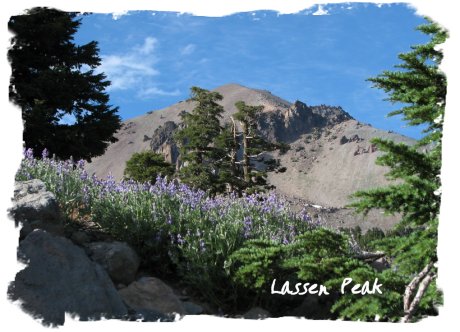
I love going to Lassen Volcanic National Park. It was a trip I made often while living in California, and I liked it enough to bring Denise here on our very first camping trip together. A lot of people have never heard of Lassen, but until Mt. St. Helens erupted, Lassen Peak was the last volcano in the lower 48 states to erupt. Between 1915 - 1917 this Northern California volcano erupted multiple times. Several of the eruptions were photographed by B.F. Loomis, whose photographs created a sensation when published. Already a national monument when it erupted, Lassen was rapidly ‘promoted’ to a National Park in 1916, largely due to Loomis’s photos.
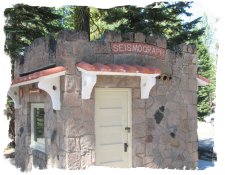 Benjamin Loomis studied Lassen Peak and the surrounding volcanoes for much of his life – his home is now used as a ranger station, and he built the Loomis Museum in 1927. The museum is used at Lassen, serving as the visitor center for the northern entrance to the park. Loomis also built a seismograph that is still in operation, located just outside the museum.
Benjamin Loomis studied Lassen Peak and the surrounding volcanoes for much of his life – his home is now used as a ranger station, and he built the Loomis Museum in 1927. The museum is used at Lassen, serving as the visitor center for the northern entrance to the park. Loomis also built a seismograph that is still in operation, located just outside the museum.Lassen Peak is part of the famous 'Ring of Fire', a line of volcanic activity that circles the Pacific Oceans. In the U.S., Lassen is joined by (not a complete list) Mt. Shasta, Mt. Ranier, Mt. Hood, Mt. Jefferson, Mt. Adams, Mt. Baker, Crater Lake and of course Mt. St Helens. Lassen Peak occupies an interesting geologic site, anchoring the southern end of the Cascade mountain range, and almost due east of Cape Mendiceno, sort of a triple junction of tectonic plates. This results in a lot of seismic activity in the area.
From Wikipedia:
The Cape Mendocino region of California's north coast is one of the most seismically active regions in the "Lower Forty-eight" United States.....Just offshore of Cape Mendocino, there is an unstable triple junction where three tectonic plates come together. The San Andreas Fault, a transform boundary, runs south from the junction, separating the Pacific Plate and the North American Plate. To the north lies the Cascadia subduction zone, where the Gorda Plate is being subducted under the margin of the North American plate. Running west from the triple junction is the Mendocino Fracture Zone, the transform boundary between the Gorda Plate and the Pacific Plate.
Where you have this kind of potential for the old shake, rattle and roll, volcanic activity is probably nearby.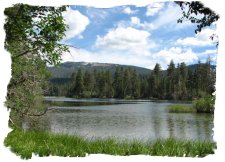 Although the park is largely about volcanos, it is a surprisingly lush and beautiful setting. It is a great park for hiking, and it is far enough north that you start to see the Douglas Firs and Spruce that you tend to associate with the Pacific Northwest. The northeast side of Lassen was devastated in a huge mudslide during the eruptions. The area is recovering – in the 15+ years it has been since I last visited Lassen, the vegetation in this area has grown considerably.
Although the park is largely about volcanos, it is a surprisingly lush and beautiful setting. It is a great park for hiking, and it is far enough north that you start to see the Douglas Firs and Spruce that you tend to associate with the Pacific Northwest. The northeast side of Lassen was devastated in a huge mudslide during the eruptions. The area is recovering – in the 15+ years it has been since I last visited Lassen, the vegetation in this area has grown considerably.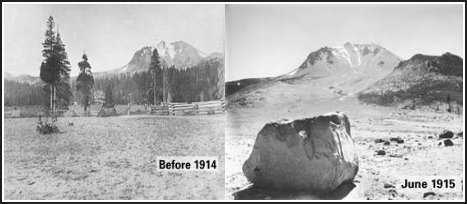
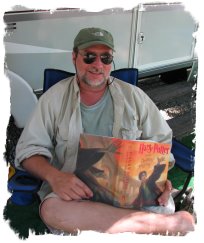 We had two goals in mind when we reached the park for a 3 day stay – first, to visit the ‘Bumpass Hell’ area, containing hot springs, mud pots and fumaroles. I also wanted us to hike to the top of Lassen Peak. Knowing I had a day to spare, I gleefully settled down to read the latest (and last) of the Harry Potter novels, and we took the first day ‘off’. We call these Zero Days, in honor of ‘Zero’, an Appalachian Trail thru hiker whose blog Denise has been reading avidly. Whenever he gets really tired, he gives himself a ‘Zero’ day to recover. So I settled in and read the day away, in the lovely and cool California weather.
We had two goals in mind when we reached the park for a 3 day stay – first, to visit the ‘Bumpass Hell’ area, containing hot springs, mud pots and fumaroles. I also wanted us to hike to the top of Lassen Peak. Knowing I had a day to spare, I gleefully settled down to read the latest (and last) of the Harry Potter novels, and we took the first day ‘off’. We call these Zero Days, in honor of ‘Zero’, an Appalachian Trail thru hiker whose blog Denise has been reading avidly. Whenever he gets really tired, he gives himself a ‘Zero’ day to recover. So I settled in and read the day away, in the lovely and cool California weather.Ignore ‘strike while the iron’s hot’ at your peril…..
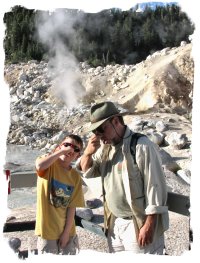 Our trip to ‘hell’ and back went great. Bumpass Hell can best be described as a miniature Yellowstone. For starters, it smells bad – really bad. After a beautiful hike, passing blooming fields of lupine and large boulder fields, you reach the geothermal area. From the overlook, you see a large area of steam vents and bubbling substances.
Our trip to ‘hell’ and back went great. Bumpass Hell can best be described as a miniature Yellowstone. For starters, it smells bad – really bad. After a beautiful hike, passing blooming fields of lupine and large boulder fields, you reach the geothermal area. From the overlook, you see a large area of steam vents and bubbling substances.Double, double toil and trouble;
Fire burn, and caldron bubble.
Bumpass Hell is named after Kendall Bumpass, a cowboy and guide. While leading a set of journalists through the area, he fell through the crust, resulting the amputation of his leg. Today, we stay safely on the boardwalks, marveling at the bravery (or stupidity) of those who risked the hot boiling cauldrons for a better view. There are no geysers at Bumpass Hell, but there is plenty else to look at. It’s a hissing, gurgling and blurping kind of hell, enough to keep you awake at nights imagining it.
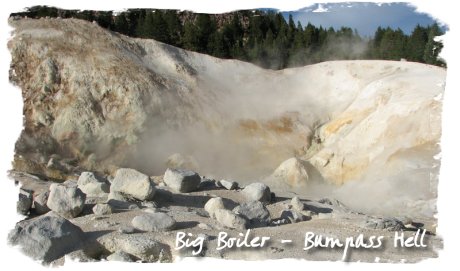
On the hike back to the car, I pointed out to Vance our intended destination – the top of Lassen Peak. He was less than enthusiastic about the hike. He’s funny – he’ll moan and groan about the hiking, but he always enjoys them. Towards the end of the hikes, when you think he’d be getting tired, he gets a burst of energy and wants to take off. Go figure….but in fairness, he’s done a lot of hiking on this trip, and hangs in there pretty good.
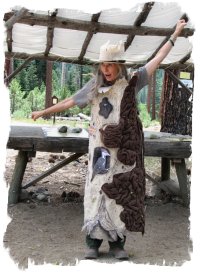 We started our final day at Lassen with a, what else, ranger program. In this case it was a program on ‘A 400 year old (dead) tree’. This was quite a production, put on by longtime Lassen Ranger Kathy Carlise. Wearing a ‘tree suit’, the tree slowly becomes home to bacteria, fungi, owls, beetles, and a whole host of other critters who use the tree for shelter and nutrients. Members of the audience were all given a picture of the organism in question to stick on the tree at the appropriate time. For a dead tree, it was a rather energetic performance, and one we aren’t likely to soon forget!
We started our final day at Lassen with a, what else, ranger program. In this case it was a program on ‘A 400 year old (dead) tree’. This was quite a production, put on by longtime Lassen Ranger Kathy Carlise. Wearing a ‘tree suit’, the tree slowly becomes home to bacteria, fungi, owls, beetles, and a whole host of other critters who use the tree for shelter and nutrients. Members of the audience were all given a picture of the organism in question to stick on the tree at the appropriate time. For a dead tree, it was a rather energetic performance, and one we aren’t likely to soon forget!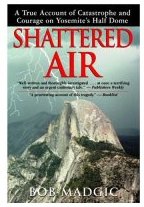 About this time big black clouds started gathering around the peak. Denise had just finished ‘Shattered Air’, a story of a lightning strike on Yosemite’ Half Dome that killed and maimed several hikers in 1985. The book is full of interesting information on all the various ways lightning can zap you, which rather gave us the willies when thinking back to our adventure in Guadalupe Mtns National Park (where we were caught in a hailstorm). In any case, the book stressed the importance of not being caught on an exposed mountaintop in a storm. After reading that book, we were in no mood to tempt fate, so we called off our afternoon hike. Bummer…..About the time we got back to the campground (a really nice KOA, one of our favorites), the weather cleared back up again. Urgggghh!
About this time big black clouds started gathering around the peak. Denise had just finished ‘Shattered Air’, a story of a lightning strike on Yosemite’ Half Dome that killed and maimed several hikers in 1985. The book is full of interesting information on all the various ways lightning can zap you, which rather gave us the willies when thinking back to our adventure in Guadalupe Mtns National Park (where we were caught in a hailstorm). In any case, the book stressed the importance of not being caught on an exposed mountaintop in a storm. After reading that book, we were in no mood to tempt fate, so we called off our afternoon hike. Bummer…..About the time we got back to the campground (a really nice KOA, one of our favorites), the weather cleared back up again. Urgggghh!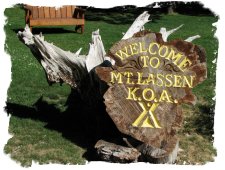 Hoping to stay another day, we checked with the campground to see if we could extend our visit. Unfortunately, the campground was booked. We considered trying to move up to the park in one of the first come first serve campgrounds, but the next morning I woke up with the familiar and unwelcome ‘twinge’ in my foot that announces that my crazy foot pains were about to start up. So we bagged the idea again. I hated it – I’ve hiked the peak several times, and it offers great views of Mt. Shasta, and the crater itself is rather interesting
Hoping to stay another day, we checked with the campground to see if we could extend our visit. Unfortunately, the campground was booked. We considered trying to move up to the park in one of the first come first serve campgrounds, but the next morning I woke up with the familiar and unwelcome ‘twinge’ in my foot that announces that my crazy foot pains were about to start up. So we bagged the idea again. I hated it – I’ve hiked the peak several times, and it offers great views of Mt. Shasta, and the crater itself is rather interestingMoral of the story….don’t spend a nice, cloudless day reading Harry Potter!

Vance: Lassen Volcanic NP is in a seismic circle called the Pacific Ring of Fire. It is known for Lassen Peak’s chain eruptions from 1914 to 1921. It is also known for its many volcanic formations. Lassen Peak is an example of a plug dome volcano where its own magma has sealed the eruption spout.
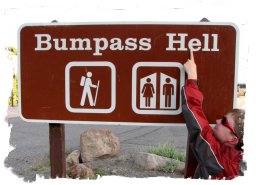 One hydrothermal section is called Bumpass Hell. A man named Kendall Vanhook Bumpass lost a leg when he fell through to the boiling water below. These pools are naturally heated to over 200 degrees. If you go there, it smells like rotten eggs.
One hydrothermal section is called Bumpass Hell. A man named Kendall Vanhook Bumpass lost a leg when he fell through to the boiling water below. These pools are naturally heated to over 200 degrees. If you go there, it smells like rotten eggs. I IMAGINE SOMBODY GOING DOWN THE TRAIL AND SEEING THE SPRINGS AND YELLING, “OH MY GOSH KIDS, IT’S HELL!!!!
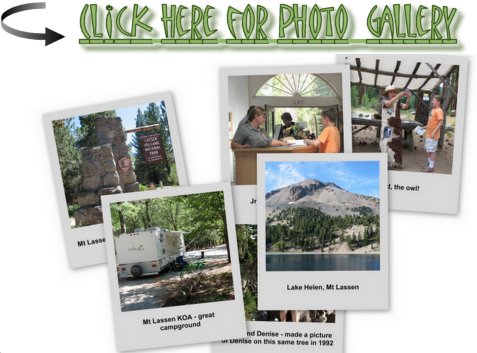
| Previous - Hetch Hetchy | | Home | Index | | Ishi In Two Worlds - Next |







<< Home